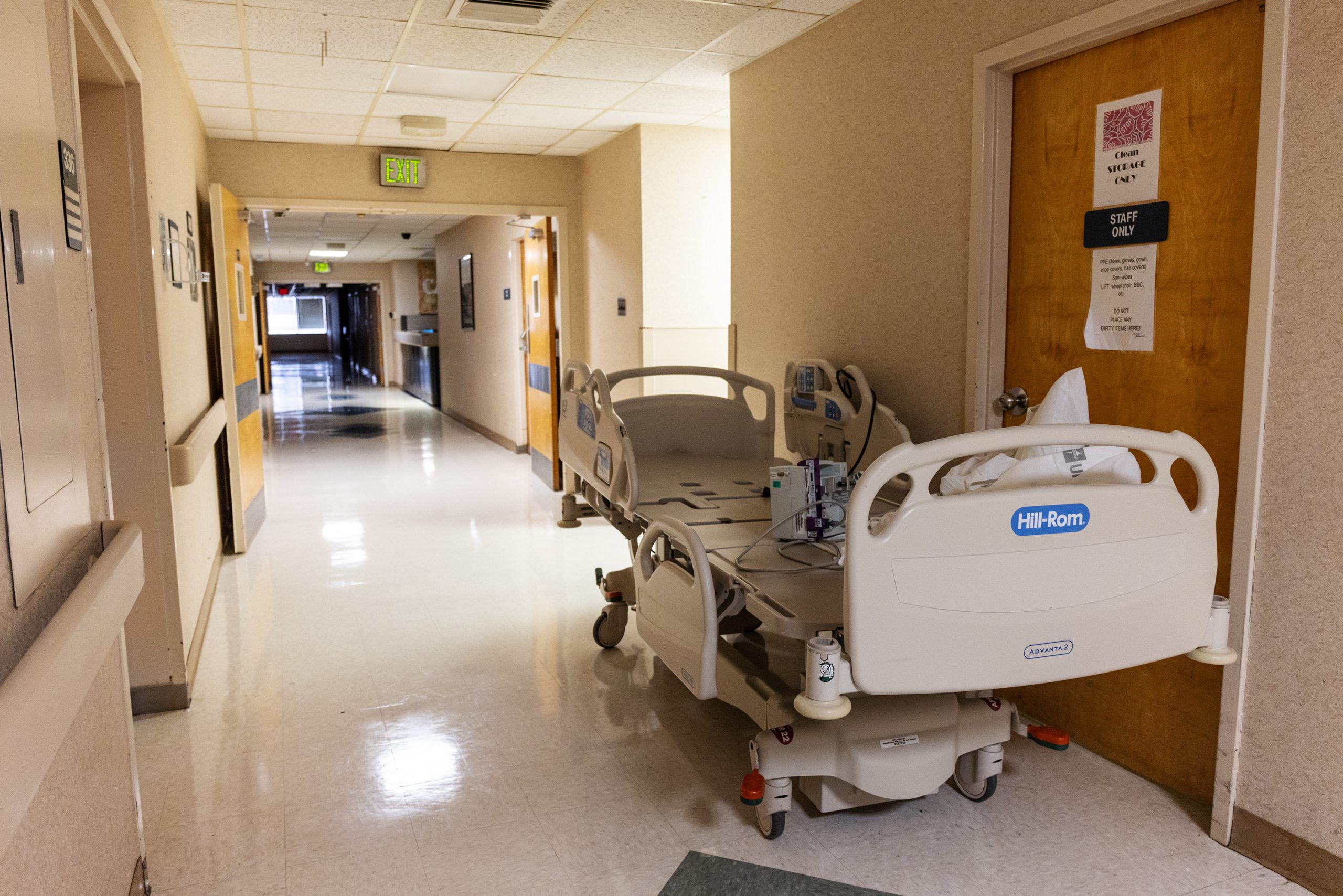Mississippi Today
In last ditch effort to stay open, Holly Springs hospital ends inpatient care

In last ditch effort to stay open, Holly Springs hospital ends inpatient care
Alliance Healthcare System in Holly Springs is Mississippi’s first rural emergency hospital – the first in a trend some say indicates the further decline of health care access in the one of the country’s poorest and sickest states.
Hospitals were able to apply for the new federal designation mere weeks ago, when the Mississippi Department of Health rolled out its rules for “rural emergency hospitals.” The federal government finalized the program in November.
Rural emergency hospitals are a step below critical access hospitals, which must have 25 or fewer inpatient beds, provide emergency services, keep its patients for less than 96 hours and be located at least 35 miles from another hospital.
The resources at rural emergency hospitals are even fewer — they must end all inpatient care and transfer patients to larger hospitals within 24 hours of the patient coming to the emergency room.
The hospital has already begun getting rid of all its inpatient beds and discharging current patients, as reported by the South Reporter, Marshall County’s community newspaper, on Wednesday. The acute care center is currently licensed for 40 beds, though its daily census doesn’t go much higher than four or five patients a day, according to hospital CEO Dr. Kenneth Williams.
The hospital has partnered with North Mississippi Medical Center and will transfer its patients there if necessary, he said.
He also said Alliance is one of just a handful of hospitals across the country approved for the designation so far.
As of Thursday, spokespeople from the state Department of Health said Alliance’s new hospital designation hadn’t been approved by the Centers for Medicare and Medicaid Services. But according to Williams, it had been approved by both required parties, CMS and the state Health Department, on Wednesday.
“I haven’t even had a chance to share this with my staff,” he said Thursday. “Yesterday was an exciting day for me to have that designation. I’m looking forward to the future to see how it works out.”
Rural emergency hospitals also can’t provide swing bed services, which means if a hospital operates a nursing home, that has to close. Alliance does not operate a nursing home.
Both rural emergency and critical access hospital designations are meant to ease financial stress — if a hospital qualifies as either, in exchange, they get paid more for their services. Rural emergency hospitals also get monthly payments from the federal government.
The program is aimed at preventing the closure of rural hospitals and creating a way they can increase financial viability and maintain operations. The idea is that rural hospitals at risk of closure already struggle with low patient counts and low payments for inpatient care.
But it’s meant as a last resort for hospitals that are barely surviving because of the limited amount of services a rural emergency hospital can offer.
State Health Officer Dr. Dan Edney considers it a closure when a hospital converts to an REH because of the loss of services. He tweeted in early February about the state’s first “loss” of a hospital, which is around the time Alliance applied for the designation with the Centers for Medicare and Medicaid Services and the Mississippi Department of Health. He compared rural emergency hospitals to triage units.
Williams, on the other hand, sees them as “expanded outpatient hospital systems.”
Rep. John Faulkner, a Democrat who represents Holly Springs, was not immediately available for comment Friday morning.
Williams bought the hospital two decades ago when he heard it was struggling. During its first years under Williams, he said the hospital was making money. Then in 2006, it lost almost $2 million with the arrival of Medicare Advantage plans, which are privatized versions of Medicare that often deny needed care and underpay hospitals.
Holly Springs is a certified retirement community, which means most of the hospital’s patients are on Medicare.
They’ve had good years and bad years since, but it’s been mostly downhill, especially since the pandemic began.
“I knew that our hospital couldn’t exist under the payment system it is under right now,” Williams said.
A little more than a decade ago, Alliance tried applying to become a critical access hospital. They were rejected because of the hospital’s proximity to Memphis.
Now, Williams says the federal rules are a little more relaxed, and he decided to apply at the recommendation of his partner, Quentin Whitwell, who operates hospitals in north Mississippi and serves as legal counsel for Alliance Healthcare, and the hospital’s financial team.
“With REH, the robust outpatient services the clinic brings to the community will be enhanced, along with continued 24/7 coverage, and the costly services will be reduced while receiving an annual subsidy,” Whitwell said when reached by text Thursday. “We are glad it worked out.”
Few Mississippi hospitals are making money, especially in the state’s more rural regions. The problem is multifaceted, but experts say the crisis has resulted from a combination of state leaders’ refusal to expand Medicaid, insurance companies’ low reimbursement rates and the pandemic forcing costs up in all areas, including staffing.
“The funding of health care in rural America is going down,” Edney previously told Mississippi Today in an interview. “There is no one coming to the rescue.”
Williams said many of the challenges hospitals are facing lead back to insurance payments and managed care plans, like Medicare Advantage.
He could’ve closed the hospital back in 2012, Williams said, when it first applied for critical access status, but he’s done everything he can to keep it open, including some layoffs and reorganizing their staff.
But at some point, “you cut muscle instead of fat,” Williams said.
One report from the Center for Healthcare Quality and Payment Reform puts a third of rural Mississippi hospitals at risk of closure, and half of those within a few years.
“Too many small rural hospitals are closing,” Williams said. “Big hospitals are struggling, whether or not they admit it, but you can get by if you’re doing high-end procedures.
“But just to take care of a regular patient who has congestive heart failure, with diabetic ketoacidosis, who is sick, they (insurance companies) don’t want to pay you for it.”
According to data from the CHQPR, Alliance Health has been losing money for the past few years, both overall and specifically taking care of patients.
And just in case the rural emergency hospital structure doesn’t work, Alliance is still applying for the critical access designation, too. If the new designation doesn’t stabilize the hospital, it can revert to its original status as an acute care facility or, if it is approved for the critical access hospital designation, it can convert to that, instead.
“Would I prefer to have us continue to operate the way that we were, having patients be admitted? Absolutely,” Williams said. “It is unfortunate that we had to make this move, but it is the right move based on the reality of health care and this payment system.”
According to Edney, Mississippi can likely expect more conversions to rural emergency hospitals – or, as he refers to them, “closures” – in the coming months.
This article first appeared on Mississippi Today and is republished here under a Creative Commons license.
Mississippi Today
1964: Mississippi Freedom Democratic Party was formed
April 26, 1964

Civil rights activists started the Mississippi Freedom Democratic Party to challenge the state’s all-white regular delegation to the Democratic National Convention.
The regulars had already adopted this resolution: “We oppose, condemn and deplore the Civil Rights Act of 1964 … We believe in separation of the races in all phases of our society. It is our belief that the separation of the races is necessary for the peace and tranquility of all the people of Mississippi, and the continuing good relationship which has existed over the years.”
In reality, Black Mississippians had been victims of intimidation, harassment and violence for daring to try and vote as well as laws passed to disenfranchise them. As a result, by 1964, only 6% of Black Mississippians were permitted to vote. A year earlier, activists had run a mock election in which thousands of Black Mississippians showed they would vote if given an opportunity.
In August 1964, the Freedom Party decided to challenge the all-white delegation, saying they had been illegally elected in a segregated process and had no intention of supporting President Lyndon B. Johnson in the November election.
The prediction proved true, with white Mississippi Democrats overwhelmingly supporting Republican candidate Barry Goldwater, who opposed the Civil Rights Act. While the activists fell short of replacing the regulars, their courageous stand led to changes in both parties.
This article first appeared on Mississippi Today and is republished here under a Creative Commons Attribution-NoDerivatives 4.0 International License.![]()
Mississippi Today
Mississippi River flooding Vicksburg, expected to crest on Monday
Warren County Emergency Management Director John Elfer said Friday floodwaters from the Mississippi River, which have reached homes in and around Vicksburg, will likely persist until early May. Elfer estimated there areabout 15 to 20 roads underwater in the area.
“We’re about half a foot (on the river gauge) from a major flood,” he said. “But we don’t think it’s going to be like in 2011, so we can kind of manage this.”
The National Weather projects the river to crest at 49.5 feet on Monday, making it the highest peak at the Vicksburg gauge since 2020. Elfer said some residents in north Vicksburg — including at the Ford Subdivision as well as near Chickasaw Road and Hutson Street — are having to take boats to get home, adding that those who live on the unprotected side of the levee are generally prepared for flooding.



“There are a few (inundated homes), but we’ve mitigated a lot of them,” he said. “Some of the structures have been torn down or raised. There are a few people that still live on the wet side of the levee, but they kind of know what to expect. So we’re not too concerned with that.”
The river first reached flood stage in the city — 43 feet — on April 14. State officials closed Highway 465, which connects the Eagle Lake community just north of Vicksburg to Highway 61, last Friday.

Elfer said the areas impacted are mostly residential and he didn’t believe any businesses have been affected, emphasizing that downtown Vicksburg is still safe for visitors. He said Warren County has worked with the U.S. Army Corps of Engineers and the Mississippi Emergency Management Agency to secure pumps and barriers.
“Everybody thus far has been very cooperative,” he said. “We continue to tell people stay out of the flood areas, don’t drive around barricades and don’t drive around road close signs. Not only is it illegal, it’s dangerous.”
NWS projects the river to stay at flood stage in Vicksburg until May 6. The river reached its record crest of 57.1 feet in 2011.




This article first appeared on Mississippi Today and is republished here under a Creative Commons Attribution-NoDerivatives 4.0 International License.![]()
Mississippi Today
With domestic violence law, victims ‘will be a number with a purpose,’ mother says
Joslin Napier. Carlos Collins. Bailey Mae Reed.
They are among Mississippi domestic violence homicide victims whose family members carried their photos as the governor signed a bill that will establish a board to study such deaths and how to prevent them.
Tara Gandy, who lost her daughter Napier in Waynesboro in 2022, said it’s a moment she plans to tell her 5-year-old grandson about when he is old enough. Napier’s presence, in spirit, at the bill signing can be another way for her grandson to feel proud of his mother.
“(The board) will allow for my daughter and those who have already lost their lives to domestic violence … to no longer be just a number,” Gandy said. “They will be a number with a purpose.”
Family members at the April 15 private bill signing included Ashla Hudson, whose son Collins, died last year in Jackson. Grandparents Mary and Charles Reed and brother Colby Kernell attended the event in honor of Bailey Mae Reed, who died in Oxford in 2023.
Joining them were staff and board members from the Mississippi Coalition Against Domestic Violence, the statewide group that supports shelters and advocated for the passage of Senate Bill 2886 to form a Domestic Violence Facility Review Board.
The law will go into effect July 1, and the coalition hopes to partner with elected officials who will make recommendations for members to serve on the board. The coalition wants to see appointees who have frontline experience with domestic violence survivors, said Luis Montgomery, public policy specialist for the coalition.
A spokesperson from Gov. Tate Reeves’ office did not respond to a request for comment Friday.
Establishment of the board would make Mississippi the 45th state to review domestic violence fatalities.
Montgomery has worked on passing a review board bill since December 2023. After an unsuccessful effort in 2024, the coalition worked to build support and educate people about the need for such a board.
In the recent legislative session, there were House and Senate versions of the bill that unanimously passed their respective chambers. Authors of the bills are from both political parties.
The review board is tasked with reviewing a variety of documents to learn about the lead up and circumstances in which people died in domestic violence-related fatalities, near fatalities and suicides – records that can include police records, court documents, medical records and more.
From each review, trends will emerge and that information can be used for the board to make recommendations to lawmakers about how to prevent domestic violence deaths.
“This is coming at a really great time because we can really get proactive,” Montgomery said.
Without a board and data collection, advocates say it is difficult to know how many people have died or been injured in domestic-violence related incidents.
A Mississippi Today analysis found at least 300 people, including victims, abusers and collateral victims, died from domestic violence between 2020 and 2024. That analysis came from reviewing local news stories, the Gun Violence Archive, the National Gun Violence Memorial, law enforcement reports and court documents.
Some recent cases the board could review are the deaths of Collins, Napier and Reed.
In court records, prosecutors wrote that Napier, 24, faced increased violence after ending a relationship with Chance Fabian Jones. She took action, including purchasing a firearm and filing for a protective order against Jones.
Jones’s trial is set for May 12 in Wayne County. His indictment for capital murder came on the first anniversary of her death, according to court records.
Collins, 25, worked as a nurse and was from Yazoo City. His ex-boyfriend Marcus Johnson has been indicted for capital murder and shooting into Collins’ apartment. Family members say Collins had filed several restraining orders against Johnson.
Johnson was denied bond and remains in jail. His trial is scheduled for July 28 in Hinds County.
He was a Jackson police officer for eight months in 2013. Johnson was separated from the department pending disciplinary action leading up to immediate termination, but he resigned before he was fired, Jackson police confirmed to local media.
Reed, 21, was born and raised in Michigan and moved to Water Valley to live with her grandparents and help care for her cousin, according to her obituary.
Kylan Jacques Phillips was charged with first degree murder for beating Reed, according to court records. In February, the court ordered him to undergo a mental evaluation to determine if he is competent to stand trial, according to court documents.
At the bill signing, Gandy said it was bittersweet and an honor to meet the families of other domestic violence homicide victims.
“We were there knowing we are not alone, we can travel this road together and hopefully find ways to prevent and bring more awareness about domestic violence,” she said.
This article first appeared on Mississippi Today and is republished here under a Creative Commons Attribution-NoDerivatives 4.0 International License.
-

 News from the South - Florida News Feed6 days ago
News from the South - Florida News Feed6 days agoJim talks with Rep. Robert Andrade about his investigation into the Hope Florida Foundation
-

 News from the South - Alabama News Feed5 days ago
News from the South - Alabama News Feed5 days agoPrayer Vigil Held for Ronald Dumas Jr., Family Continues to Pray for His Return | April 21, 2025 | N
-

 News from the South - Florida News Feed5 days ago
News from the South - Florida News Feed5 days agoTrump touts manufacturing while undercutting state efforts to help factories
-

 Mississippi Today6 days ago
Mississippi Today6 days ago‘Trainwreck on the horizon’: The costly pains of Mississippi’s small water and sewer systems
-

 News from the South - Texas News Feed6 days ago
News from the South - Texas News Feed6 days agoMeteorologist Chita Craft is tracking a Severe Thunderstorm Warning that's in effect now
-

 News from the South - Virginia News Feed5 days ago
News from the South - Virginia News Feed5 days agoTaking video of military bases using drones could be outlawed | Virginia
-

 News from the South - Florida News Feed5 days ago
News from the South - Florida News Feed5 days agoFederal report due on Lumbee Tribe of North Carolina’s path to recognition as a tribal nation
-

 News from the South - Oklahoma News Feed5 days ago
News from the South - Oklahoma News Feed5 days agoOklahoma Treasurer’s Office Faces Scrutiny Over Use of Signal in Anti-ESG Coordination
















































